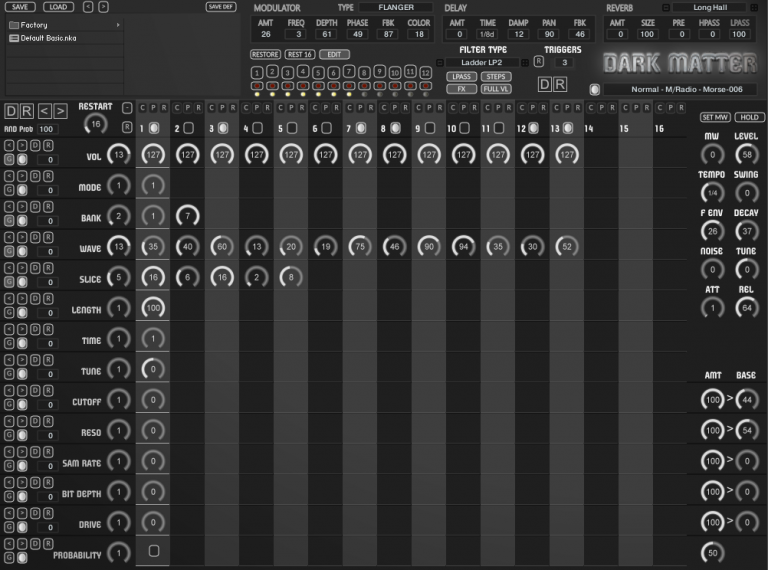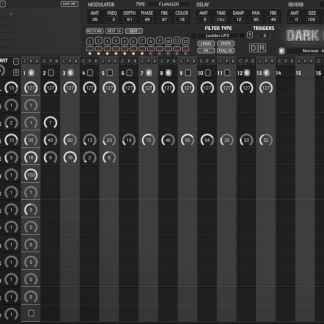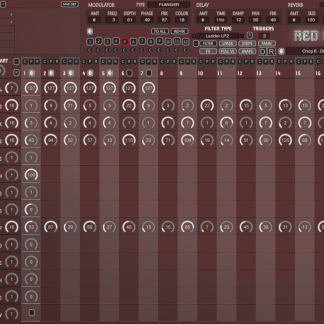 There is also a snapshot feature which features 12 virtual Sequences which can be copied from the main Sequencer. They are either triggered via a dedicated octave of Midi Triggers, or the buttons can be automated. The send to snapshot buttons can also be automated and so there is the creative freedom to make snapshots as part of the performance.
There is also a snapshot feature which features 12 virtual Sequences which can be copied from the main Sequencer. They are either triggered via a dedicated octave of Midi Triggers, or the buttons can be automated. The send to snapshot buttons can also be automated and so there is the creative freedom to make snapshots as part of the performance.
The snapshots are rolled out to 16 steps from the polyrhythmic sequence, which means they are always in sync. Also Because shifting a polyrhythmic sequence left/right is impossible should you want to change the start step, it can be copied to a snapshot, shifted and sent back which works most of the time. There are two playback modes defined by the Edit switch. With the edit switch off, the knobs of the main Sequence are hidden but the snapshot will play back meaning that Automation will not overwrite the snapshot. When not automating edit mode provides full editing so it can be used more like a traditional pattern Sequencer.
Red Matter
 The v1.1 Update adds a Second Instrument called Red Matter which is identical to Dark Matter except it uses a traditional Pattern based system like Emergent Properties and other HGS Instruments. The update also includes the addition of Remix, Copy to All and a Row Option menu to each Sequencer row to Dark Matter. The Row menu functions can be used to duplicate x steps or to copy the row to any or all Patterns, as well as Copy/Remix the Row in all other sequences.
The v1.1 Update adds a Second Instrument called Red Matter which is identical to Dark Matter except it uses a traditional Pattern based system like Emergent Properties and other HGS Instruments. The update also includes the addition of Remix, Copy to All and a Row Option menu to each Sequencer row to Dark Matter. The Row menu functions can be used to duplicate x steps or to copy the row to any or all Patterns, as well as Copy/Remix the Row in all other sequences.
A video showing some of the presets, but its easy and fun to create your own.
A guide to the features:
The source material uses 889 Loops spread over 7 Banks as follows:
- Analog – Synth Sequences made with an Analog Four and DSI Evolver specifically for this Instrument.
- Morphs – A set of sounds which morph between different sounds As well as some classic Wavetable morphs.
- Mixed – More morphs and a collection of radio voices and morse code.
- Hits A – Single Drum hits chained in sequence.
- Hits B – A 2nd bank of Drum Hits.
- Drum Loops A – A collection of diverse drum loops.
- Drum Loops B – A second set of drum loops With a different flavour.
There are 22 Modes available which use different timestretch algorithms and sound manipulation, including modes which use LFOs to chop the Volume/Cutoff and Reverse modes. This can be very interesting sequencing them using a single loop. The available Modes are as follows:
- Time Machine Pro
- Time Machine Pro Reversed
- TM – These use Kontakts Tone Machine Mode for a Granular Sound
- LQ – These use the Time Machine in Low Quality Mode.
- BM – Beat Machine Mode which tends to split up the slices more like a Gate Effect.
- BRIGHT – Uses TM Pro but has a brighter formant sound.
- CHOPPER 8 – The Chopper Modes use an LFO SAW shape to affect the Volume and Filter Cutoff.
- CHOPPER 16
- CHOPPER 32
- CHOPPER 6
- CHOPPER 3
- CHOPPER 8 – Reversed
- CHOPPER 16 – Reversed
- CHOPPER 32 – Reversed
- CHOPPER 6 – Reversed
- CHOPPER 3 – Reversed
- SQ CHOP 8 – uses a Square Waveform,
- SQ CHOP 16
- SQ CHOP 8 – Reversed
- SQ CHOP 16 – Reversed
- SINE Slow – uses a Sine wave in free sync mode.
- SINE Faster




pacques –
Homegrown Sounds released a library, back in 200?, which was given to me, along with Kontakt 2 and thus I began my use of a very popular sampler. It is 2019 and Kontakt 6 is here, allowing more under the hood scripting and not many utilise this like HGsounds do. Dark Matter, their latest library, is a case in point: even after half a day and for only $19.99, I have produced sounds and sequences, which a library costing 5 times as much, would have difficulty matching: both in satisfaction, simplicity of use, especially with a well written manual and also stability and sheer joy. Dark Matter has already reached a place in my collection, where I may wonder if I can remember not owning it!
Paj –
+1 for everything pacques previously noted. If you’re familiar with the four Modular Chaos Engines from Sound Dust, you’ll love and appreciate this Kontakt instrument as its own separately-evolved species, just loaded to the gills with deep-featured, inspirational randomization. It’s difficult to even estimate how many new patterns/loops/sounds you can generate from any single starting point. It quickly made a hallmark for itself in my Kontakt arsenal. You have to love a developer that creates instruments that make your creative juices flow, time and time again, whenever you load them up.